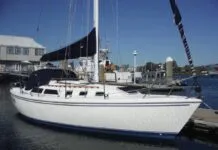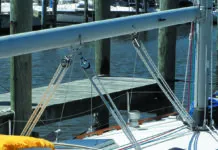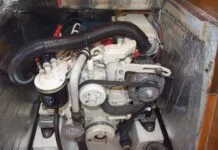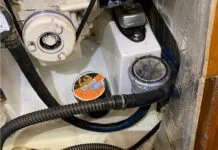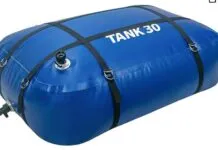Brush choice depends on what the brush’s job will be (transferring paint, smoothing paint, etc.), the user’s preferences, and the project budget. The best brush isn’t necessarily the best brush for the project. You wouldn’t use a $40 brush that requires meticulous cleaning to paint the bilge or apply bottom paint, just as you wouldn’t use a throw-away chip brush to lay a final coat of varnish on the toerail—at least we wouldn’t.
As Don Casey put it in his marine-maintenance bible, “This Old Boat”: Varnish will forgive some technique flaws, but it won’t forgive the wrong brush. Cheap brushes typically don’t hold paint well, apply it unevenly, and shed bristles—unappealing traits for a topside paint or varnish brush. Expensive brushes are crafted for optimum performance, but they are an investment and must be tended to properly to ensure a long, useful life. (See “Care and Cleaning”)
Synthetic vs. Natural
Most natural bristles are made from hog bristle; they’re often called China bristle because China is the largest supplier of them. A good-quality China bristle is adequate for most finishing jobs. The next step up is ox hair, which is often a mix of hog and ox, and the best finishing brushes are badger hair. These are ideal for tipping-out polyurethane paints and final coats of varnish. With any of these types, there is a range of qualities available, so be sure to examine a brush for quality before you purchase it.
Synthetic bristles, typically made of nylon or polyester, are less expensive than natural-bristle brushes, but they lack flagged (split) bristle ends so they don’t hold as much paint or lay it on as evenly. While you can achieve good varnish results with a foam brush, we would never recommend a synthetic-bristle brush for finishing jobs aboard a boat.
Construction & Shape
Brush construction is as important as bristle choice when it comes to matching a brush with a job. Handcrafted brushes with hand-chiseled tips and thick, flagged bristles have more paint capacity than flat-edged brushes, enabling longer strokes and more uniform paint transfer.
Handle shape and construction material is a matter of personal preference. Our testers preferred the beefier, beaver-tail-style handles because they fit in our hands well, but they are the hardest to fit in a brush spinner for cleaning. We also prefer slightly finished wood handles, as they are easier to keep clean.
The brush ferrule should be of a rust-resistant metal, and the bristles should be adhered with epoxy or vulcanized rubber. There should be no noticeable gaps in the bristles, and if there’s a plug inside the brush, it should be a thin one.
The job at hand determines what shape the brush head needs to be. Rectangular heads are good for coating flat surfaces, which are few and far between on a boat. Brushes with oval cross-sections retain more paint and are the best bet for top-coating varnish or tipping-out LPU. Round brushes are good for trim and cutting in. If you’re going to invest in one or two quality brushes, oval is the way to go. (Never use a varnish brush for painting or vice versa.)
Matching the Brush with the Job
For varnishing: You need a brush that is dense, has a chisel tip, and absolutely will not shed bristles. This could be a good badger-hair brush or even a foam brush. Both Casey and Rebecca Whitman (professional wood finisher and author of “Brightwork, The Art of Finishing Wood”) extol the good performance, easy cleanup, and environmental friendlier-ness (no solvents required for cleanup) of the Jen Poly-foam brushes.
For painting: Foam brushes won’t fly with polyurethane paints, plus you want the brush to hold plenty of paint, so a bristle brush is better. Disposable, throwaway China chip brushes are adequate for small jobs or those where perfection isn’t a priority. If you’re rolling-and-tipping a hull and will realistically follow a brush cleaning regimen, then an oval-shaped badger- or China-bristle brush with a chiseled, fan-shaped tip is best.





